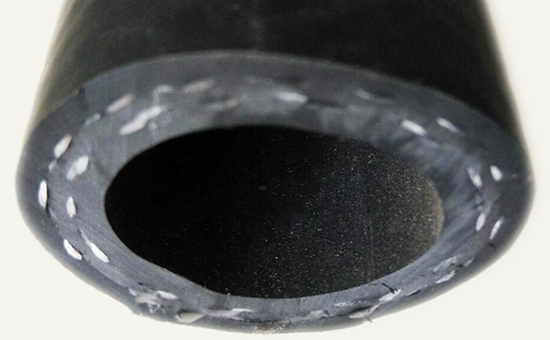
Rubber hoses are mainly used to transport various gases, liquids, viscous fluids or solid particles under positive or negative pressure, and are widely used in industry, agriculture, energy, transportation and other fields. In the actual application process, the main role of the skeleton material in the rubber hose is to improve the strength and rigidity of the hose. The structure of the hose is different, and the specific role of the skeleton material is also different. So what are the commonly used skeleton materials for the hose? What are the different roles played?
The commonly used framework materials for rubber tubes can be roughly divided into two categories: wire and fabric. Wire can be divided into fiber wire and metal wire. Fabrics include canvas and cord.
1. Fiber wire
In actual production, the commonly used fiber strands for rubber tubes include cotton thread and chemical fiber thread. Chemical fiber thread includes rayon, vinylon thread, nylon thread, polyester thread, etc.; chemical fiber thread has the characteristics of high strength and chemical corrosion resistance, and it is more and more widely used in hoses.
2. Metal wire
Commonly used metal wires for rubber hoses include steel wire, steel wire rope, general carbon steel wire, iron wire and stainless steel wire. Stainless steel wire is not easy to rust, and is mainly used for hoses that contact corrosive media, but the price is relatively high, and it is usually only used in hose skeleton materials with special requirements. Some hoses also use copper, aluminum and other static conductive metal wires. In actual production, the rubber tube can also use polyamide, polyethylene, polypropylene or rigid polyvinyl chloride instead of metal wire, which is light in texture, corrosion resistant, and has good flattening resistance.
3. Canvas skeleton
Canvas is a commonly used skeleton material in the production of rubber pipes. It has a variety of forms such as plain weave, twill weave and square weave, among which plain weave is more common. The warp and weft of the plain weave canvas are 90°, which has a higher strength-to-density ratio, and the fabric strength is higher than that of the canvas with the twill 2YLYY615 structure. In actual production, the commonly used canvases for rubber hoses are cotton canvas and chemical fiber canvas. Chemical fiber canvas also includes vinylon, vinyl-cotton blended, nylon, polyester, etc., among which vinylon and vinyl-cotton blends are more common.
4. Cord frame
The cords commonly used in the production of rubber tubes are made up of warp (cord) and weft (yarn) interlaced vertically and horizontally. The function of the warp is to provide strength, and the weft can only be used to connect and maintain the uniform arrangement of the warp in the cord. In actual production, hoses are commonly used in cotton cords, nylon cords, viscose cords, polyester cords and vinylon cords.
Rubber hoses need to choose suitable rubber and plastic materials according to the use occasion and physical requirements, including natural rubber, styrene butadiene rubber, butadiene rubber, nitrile rubber, butyl rubber, ethylene propylene rubber, silicone fluorine rubber, reclaimed rubber and polyethylene, For polyvinyl chloride, chlorinated polyethylene, polytetrafluoroethylene, etc., certain rubber and plastic materials can be used alone, or two or more materials can be used together. Choose suitable framework materials to further improve the comprehensive indicators of the rubber tube.
Exclusive original article [commercial authorization] reprint, excerpt and excerpt in any form are prohibited without written authorization. Focus on Hongyun rubber: learn the process formula and raw material technology of producing rubber products from recycled rubber to help you reduce costs and increase profits